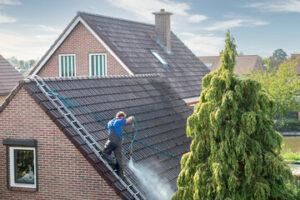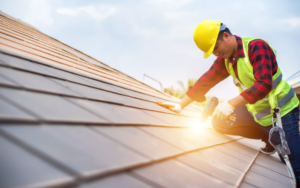Roofing Experts are the construction and installation of a building roof. It channels rainwater away from the interior, protecting walls, ceilings, and contents from water damage.
Homeowners have a wide selection of practical roofing choices. There are 64 different types of roofs to choose from, and they come in a variety of styles and colors.

As one of the most crucial elements of a home, the roof must be durable enough to withstand weather conditions. In addition, a homeowner will want to choose a roofing material that is both affordable and attractive. Various materials are used for roofing, including asphalt shingles, clay tiles, and concrete tile. Wood shakes and shingles also are an option, though they tend to require more maintenance than other types of roofing materials.
The most popular type of roof is asphalt shingle. This roofing material comes in a variety of colors and styles to fit any design preference. It is an affordable and durable choice, especially in dry climates. However, it is not as good for high-rise buildings and is prone to water damage from humidity.
Clay tiles are a great roofing material for hot climates. These earthen clays are molded into rolled or interlocking shapes and then fired for durability. They can be left unglazed to maintain the characteristic reddish-orange color or glazed to create a ceramic look. Clay tiles are one of the most expensive roofing materials but can last upwards of 50 years.
Concrete tiles are another excellent roofing option for hot climates. These durable and long-lasting tiles are made from a mix of concrete and natural fibers. They can be created to resemble several different types of roofing, including slate and clay tiles. However, they can be heavy and add a significant amount of stress to the structure of a home.
Roofing membrane is another excellent choice for flat or low-pitch roofs. These single-membrane systems are typically black, which can absorb heat and increase the energy bill, but they are available in other colors. They are a cost-effective option and very easy to install.
Metal roofs are a modern alternative to shingles and shakes. Using either aluminum or steel, they can be fabricated to resemble traditional shingles, slate, or even clay tiles. They can also withstand high winds and resist fire. These roofs are not as common as other options but offer many advantages. They are long-lasting, highly durable, and resistant to water damage.
Installation
The installation of roofing is a meticulous process that demands attention to detail and expertise. It includes a variety of steps that must be taken into account to ensure the durability and beauty of the finished product. A quality roof can protect the interior of a home from moisture, improve energy efficiency, and enhance curb appeal.
The first step in the installation process is preparing the roof area. This involves removing any existing roofing materials and making sure that the roof deck is fully prepared to support the new roofing system. It’s also important to take safety precautions during this stage to prevent injury and property damage.
Once the roof deck is ready, the next step in the process is to install underlayment. The underlayment is a layer of felt paper that protects the roof from water and wind. It’s usually installed in overlapping rows and fastened to the roof with nails that are close together near the edges and spread out more toward the middle of the underlayment.
After the underlayment is in place, it’s time to start installing shingles. The contractor will start at the bottom edge of the roof and work upward, ensuring that the shingles overlap the previous row. The shingles are then secured with a strip of tar that’s applied using a caulking gun. A vapor retarder may also be added to the roof at this point, depending on the type of roofing.
Once the shingles are in place, the final step in the process is to seal up any vents or other penetrations on the roof. This can include chimneys, skylights, and even vents that are used for sewer ventilation or to ventilate bathrooms and kitchen stoves.
Maintenance
A roof is an important investment, and a good one will provide protection for the rest of your home or building. Its construction may vary from flat, sloping surfaces to pitched or vaulted roofs with domed tops. The roof must be able to withstand rain, hail, bitter cold, intense sun, and winds that can cause damage.
Proper maintenance is essential to ensure the long life of a roof, and to reduce the risk of leaks and other damage to interior finishes, appliances, electrical systems, and fixtures. Regular inspections and timely repairs can save you money, avoid costly future problems, and help keep the value of your property intact.
Roofing professionals recommend inspecting roofs on a biannual basis to identify and repair any early signs of wear or damage. In addition, roofs should be inspected after severe weather events and at any other time that a problem is identified.
These procedures include examining the structural integrity of trusses, beams, and joists, and for any signs of water damage that might be caused by leaking or missing shingles. Examining ridge vents, chimneys, and skylights, as well as inspecting the flashing (material that seals the joints where roofing planes meet) is also important. Large areas of moss or lichen should be removed promptly to prevent damage, as should any plant growth that could puncture a roof surface.
Maintaining a healthy roof is a joint effort between the building owner and the roofing contractor. The maintenance program should be outlined in a written document that specifies the work to be performed, when it is to be completed, and who is responsible for each task.
Roofing contractors typically use construction management software tools like Builder Trends to make their onsite work easier. These programs allow them to track, monitor and manage tasks, projects, crews, and materials. Using these programs helps them stay on schedule, meet deadlines and deliver high-quality service to customers. It also helps them increase their productivity and profitability.
Repairs
Roofing repairs are essential to maintaining the structural integrity of your home. Timely repairs and inspections help prevent problems such as leaks, loose or missing shingles, and damaged flashing. By addressing these issues promptly, you can extend the life of your roof and save on energy bills in the long run.
When choosing a roof repair company, it’s important to find one with experience and excellent customer service. You should also make sure that the company you choose has liability insurance. This will protect you in the event that the work is not done correctly or if someone gets injured on the job. Additionally, a reputable company will offer competitive pricing and quality workmanship.
Re-roofing is the simplest and cheapest way to restore your roof’s appearance. However, this home improvement project does not address any hidden damages underneath the existing shingles. Plus, it can void your warranty and may not last as long as a replacement.
A good way to check the condition of your roof is to get up in the attic or crawlspace and take a look around. Look for any damp stains or peeling paint – these are red flags that indicate the presence of standing water in your roof, which is a serious problem.
Another way to evaluate your roof is to examine its energy efficiency. Leaky and poorly insulated areas can allow conditioned air to escape and outside air to infiltrate, making your heating or cooling system work harder. By conducting regular roof repairs and ensuring that the insulation is up to date, you can increase your home’s energy efficiency.
Repairing or replacing your roof can be a significant investment, so it’s important to make the right decision. Be aware of the pros and cons of each option to ensure that your roof lasts for as long as possible and protects your home and family for years to come. With proper maintenance and timely repairs, your roof can last for decades, saving you from the hassle and expense of a full replacement.

